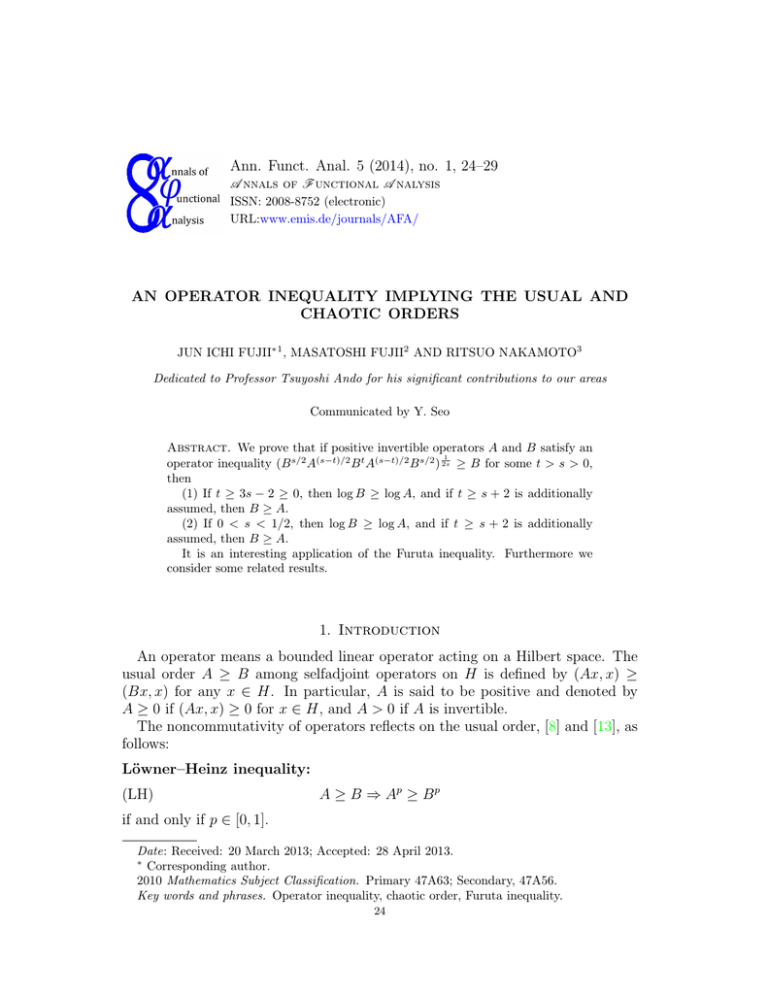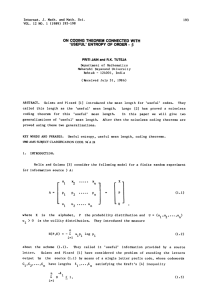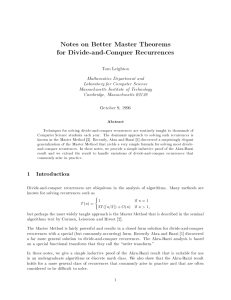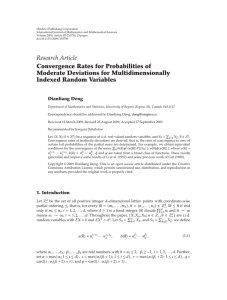Ann. Funct. Anal. 5 (2014), no. 1, 24–29 CHAOTIC ORDERS
advertisement

Ann. Funct. Anal. 5 (2014), no. 1, 24–29
A nnals of F unctional A nalysis
ISSN: 2008-8752 (electronic)
URL:www.emis.de/journals/AFA/
AN OPERATOR INEQUALITY IMPLYING THE USUAL AND
CHAOTIC ORDERS
JUN ICHI FUJII∗1 , MASATOSHI FUJII2 AND RITSUO NAKAMOTO3
Dedicated to Professor Tsuyoshi Ando for his significant contributions to our areas
Communicated by Y. Seo
Abstract. We prove that if positive invertible operators A and B satisfy an
1
operator inequality (B s/2 A(s−t)/2 B t A(s−t)/2 B s/2 ) 2s ≥ B for some t > s > 0,
then
(1) If t ≥ 3s − 2 ≥ 0, then log B ≥ log A, and if t ≥ s + 2 is additionally
assumed, then B ≥ A.
(2) If 0 < s < 1/2, then log B ≥ log A, and if t ≥ s + 2 is additionally
assumed, then B ≥ A.
It is an interesting application of the Furuta inequality. Furthermore we
consider some related results.
1. Introduction
An operator means a bounded linear operator acting on a Hilbert space. The
usual order A ≥ B among selfadjoint operators on H is defined by (Ax, x) ≥
(Bx, x) for any x ∈ H. In particular, A is said to be positive and denoted by
A ≥ 0 if (Ax, x) ≥ 0 for x ∈ H, and A > 0 if A is invertible.
The noncommutativity of operators reflects on the usual order, [8] and [13], as
follows:
Löwner–Heinz inequality:
(LH)
A ≥ B ⇒ Ap ≥ B p
if and only if p ∈ [0, 1].
Date: Received: 20 March 2013; Accepted: 28 April 2013.
∗
Corresponding author.
2010 Mathematics Subject Classification. Primary 47A63; Secondary, 47A56.
Key words and phrases. Operator inequality, chaotic order, Furuta inequality.
24
AN OPERATOR INEQUALITY
25
In 1987, Furuta [6] proposed a beautiful extension of (LH), by which the restriction p ∈ [0, 1] in (LH) is relaxed in some sense:
Furuta inequality: If A ≥ B, then for each r ≥ 0,
1
(Ar/2 B p Ar/2 ) q ≤ A
p+r
q
and B
p+r
q
1
≤ (B r/2 Ap B r/2 ) q
hold for p ≥ 0 and q ≥ 1 with
(1 + r)q ≥ p + r.
(†)
For the Furuta inequality, we refer [2],[5],[6] and [7]. Among others, the best
possibility of the domain determined by (†) is proved by Tanahashi [14].
Afterwards, the Furuta inequality was discussed under the chaotic order log A ≥
log B for A, B > 0, which was originally discussed by Ando [1], and the final result
was obtained in [3].
Theorem FFK. The following (1) - (3) are mutually equivalent for A, B > 0 :
(1) log A ≥ log B,
(2) Ap ≥ (Ap/2 B p Ap/2 )1/2 for p ≥ 0,
r
(3) Ar ≥ (Ar/2 B p Ar/2 ) p+r for p, r ≥ 0.
From the viewpoint of Kamei’s satellite theorem [12] and Uchiyama’s work [15],
we here mention that Theorem FFK is equivalent to the Furuta inequality.
Now we consider the following operator inequality for positive invertible operators A and B:
1
(B s/2 A(s−t)/2 B t A(s−t)/2 B s/2 ) 2s ≥ B.
(∗)
Recently, as an application of the Daleckii–Krein formula (see [2]) for the derivative of matrix valued function, one of the authors [4] proved that if matrices
A, B satisfy (∗) for any t > 1 and s = 1, then log B ≥ log A. In this situation,
recalling the equivalence between Theorem FFK and the Furuta inequality, it is
expected that the conclusion log B ≥ log A is built up the usual order B ≥ A.
In this note, we prove that if positive operators A and B satisfy the operator
inequality (∗) for a fixed t > s > 0, then
(1) If t ≥ 3s − 2 ≥ 0, then log B ≥ log A, and if t ≥ s + 2 is additionally
assumed, then B ≥ A.
(2) If 0 < s < 1/2, then log B ≥ log A, and if t ≥ s + 2 is additionally assumed,
then B ≥ A.
2. A preliminary result for the chaotic order
In the consideration on Kamei’s satellite theorem [12] of the Furuta inequality,
we are required some operator inequalities of Furuta type implying the chaotic
order. Consequently one of the authors announced the following result in [4]: If
positive definite matrices A, B > 0 satisfy
(B 1/2 A(1−t)/2 B t A(1−t)/2 B 1/2 )1/2 ≥ B
then log B ≥ log A.
for all t > 1,
26
J.I. FUJII, M.FUJII, R. NAKAMOTO
We now generalize it as follows:
Theorem 1. For positive definite matrices A, B > 0, if there exist α, β such that
α + β = 1 and
(B (α+βt)/2 A(1−t)/2 B β+αt A(1−t)/2 B (α+βt)/2 )1/2 ≥ B
for all t > 1,
then log B ≥ log A.
Proof. Let F (x) = x1/2 , γ(t) = B (α+βt)/2 A(1−t)/2 B β+αt A(1−t)/2 B (α+βt)/2 and Ut be
unitaries such that Ut∗ γ(t)Ut = D(t) = diag(d1 (t), · · · , dn (t)), diagonal matrices.
Here we recall the Daleckii–Krein formula
dF (γ(t))
= Ut
dt
F [1] (di (t), dj (t)) ◦ Ut∗ γ̇(t)Ut Ut∗ ,
where ◦ stands for the Hadamard–Schur product and F [1] (x, y) is the divided
difference
(
F (x)−F (y)
if x 6= y
[1]
x−y
F (x, y) =
.
F 0 (x)
if x = y
We may assume that B itself is a diagonal matrix diag(dj ), so U1 = I, the identity
matrix. Therefore, at t = 1, we obtain
di − dj
dF (γ)
1
[1] 2 2
[1] 2 2
(1) = F (di , dj ) ◦ γ̇(1) and F (di , dj ) =
=
.
dt
d2i − d2j
di + dj
It follows that
β
(log B)B (α+βt)/2 A(1−t)/2 B β+αt A(1−t)/2 B (α+βt)/2
2
+ αB (α+βt)/2 A(1−t)/2 (log B)B β+αt A(1−t)/2 B (α+βt)/2
β
+ B (α+βt)/2 A(1−t)/2 B β+αt A(1−t)/2 B (α+βt)/2 (log B)
2
1 (α+βt)/2
− B
(log A)A(1−t)/2 B β+αt A(1−t)/2 B (α+βt)/2
2
1
− B (α+βt)/2 A(1−t)/2 B β+αt (log A)A(1−t)/2 B (α+βt)/2
2
1
1
−→ γ̇(1) = (log B)B 2 − B 1/2 (log A)B 3/2 − B 3/2 (log A)B 1/2
2
2
1 1/2
= B (B(log B − log A) + (log B − log A)B) B 1/2
2
1
= (LB + RB )(B 1/2 (log B − log A)B 1/2 )
2
1
= (di + dj ) ◦ (B 1/2 (log B − log A)B 1/2 )
2
γ̇(t) =
AN OPERATOR INEQUALITY
27
as t −→ 1, so we have
dF (γ)
(1) = F [1] (di , dj ) ◦ γ̇(1)
dt
1
1
1/2
1/2
=
◦
(di + dj ) ◦ (B (log B − log A)B )
di + dj
2
1
= (B 1/2 (log B − log A)B 1/2 ).
2
On the other hand, since
(B (α+βt)/2 A(1−t)/2 B β+αt A(1−t)/2 B (α+βt)/2 )1/2 − B
dF (γ)
(1) = lim
≥ 0,
t↓1
dt
t−1
we obtain B 1/2 (log B − log A)B 1/2 ≥ 0, that is, log B ≥ log A.
3. Main Theorems
The operator inequality (∗) is a multiple version of the Furuta inequality. We
here generalize Theorem 1 to the case with 2 variables. Nevertheless, the Furuta
inequality is applicable to resolve it. In this section, we first propose the following
theorem.
Theorem 2. Suppose that A, B > 0 satisfy the inequality (∗), i.e.,
1
(B s/2 A(s−t)/2 B t A(s−t)/2 B s/2 ) 2s ≥ B
for some t > s > 0. Then the following assertions hold:
(1) If t ≥ 3s − 2 ≥ 0, then log B ≥ log A, and if the additional condition
t ≥ s + 2 is assumed, then B ≥ A.
(2) If 0 < s < 1/2, then log B ≥ log A, and if the additional condition t ≥ s + 2
is assumed, then B ≥ A.
Proof. By the Furuta inequality, we have for p = 2s and r = t − s
(B (t−s)/2 B s/2 A(s−t)/2 B t A(s−t)/2 B s/2 B (t−s)/2 )
t−s+1
t+s
≥ B t−s+1 ,
that is,
(B t/2 A(s−t)/2 B t A(s−t)/2 B t/2 )
t−s+1
t+s
≥ B t−s+1 .
Hence we have
(B t/2 A(s−t)/2 B t/2 )
2(t−s+1)
t+s
≥ B t−s+1 .
t+s
> 1 by t ≥ 3s − 2, B t/2 A(s−t)/2 B t/2 ≥ B 2 , and
Now we prove (1): As 2(t−s+1)
t+s
so A(s−t)/2 ≥ B (s−t)/2 . Consequently, we have log B ≥ log A by t > s and the
operator monotonicity of the logarithmic function. Moreover, if t ≥ s + 2, then
(t − s)/2 ≥ 1 and so B ≥ A by the Löwner–Heinz theorem.
Next, if s < 1/2, then by the Löwner–Heinz inequality, we have
B s/2 A(s−t)/2 B t A(s−t)/2 B s/2 ≥ B 2s .
Hence it follows that A(s−t)/2 B t A(s−t)/2 ≥ B s and thus
B t/2 A(s−t)/2 B t A(s−t)/2 B t/2 ≥ B s+t ,
28
J.I. FUJII, M.FUJII, R. NAKAMOTO
that is, (B t/2 A(s−t)/2 B t/2 )2 ≥ B s+t . Consequently, we have A(s−t)/2 ≥ B (s−t)/2
and the conclusion is obtained as in the proof of (1).
Corollary 3. If A, B > 0 satisfy
1
(B 1/2 A(1−t)/2 B t A(1−t)/2 B 1/2 ) 2 ≥ B
for a fixed t > 1,
then log B ≥ log A. Moreover if it satisfied for some t ≥ 3, then B ≥ A.
Unfortunately the converse in Theorem 2 does not hold.
2 1
3 0
Example 4. Let A =
,B =
, s = 1 and t = 4. Then B ≥ A and
0 2
1 1
σ((B 1/2 A(1−t)/2 B t A(1−t)/2 B 1/2 )1/2 − B) = {35.2421, −0.25003}.
Theoretically, if operators A and B satisfy (∗), then B (t−1)/2 ≥ A(t−1)/2 as in
the proof of Theorem 2. However in general, B ≥ A does not imply B (t−1)/2 ≥
A(t−1)/2 , Hence B ≥ A does not always imply (∗).
Remark 5. It must be t > 1 in order to imply B ≥ A. If A commutes with B,
then we have (A1−t B 1+t )1/2 ≥ B, that is, B t−1 ≥ At−1 . Hence B ≥ A if t > 1.
For 1 > t > 0, we prove the following theorem by applying Lyapunov equation,
see [2] and [9].
Theorem 6. If A, B > 0 satisfy (∗) for s = 1 and any t ∈ (0, 1), then log A ≥
log B.
Proof. Put Xt = B 1/2 A(1−t)/2 B t A(1−t)/2 B 1/2 . Then we have
1/2
(Xt
1/2
− B)Xt
1/2
+ B(Xt
− B) = Xt − B 2
and
Xt − B 2 =
B 1/2 {A(1−t)/2 (B t − B)A(1−t)/2 + A(1−t)/2 B(A(1−t)/2 − 1) + (A(1−t)/2 − 1)B}B 1/2 .
Here we have
Bt − B
A(1−t)/2 − 1
1
= B log B and lim
= − log A.
t→1 t − 1
t→1
t−1
2
lim
X
1/2
−B
Hence by putting Y = limt→1 tt−1 via the chain rule (cf. [11, Theorem 8.4]),
it follows that Y ≤ 0 by the assumption and
1
BY + Y B = B 1/2 (B log B − (B log A + log A B))B 1/2 .
2
By solving this Lyapunov equation,
Z 0
1
1/2
tB
tB
Y =B
e ((B log B − (B log A + log A B))e dt B 1/2
2
−∞
1
1 tB
1/2
2tB 0
tB 0
=B
log B[e ]−∞ − [e log Ae ]−∞ B 1/2
2
2
1
= B 1/2 (log B − log A)B 1/2 .
2
AN OPERATOR INEQUALITY
Since Y ≤ 0, we have log A ≥ log B.
29
References
1. T. Ando, On some operator inequality, Math. Ann. 279 (1987), 157—159.
2. R. Bhatia, Positive Definite Matrices, Princeton Univ. Press, 2007.
3. M. Fujii, Furuta’s inquality and its mean theoretic approach, J. Operator Theory 23 (1990),
67–72.
4. M. Fujii, T. Furuta and E. Kamei, Furuta’s inequality and its application to Ando’s theorem,
Linear Algebra Appl. 179(1993), 161–169.
5. J.I. Fujii, On the Daleckii-Krein differential formula of matrices (in Japanese) , The Bulletin
of International Society for Mathematical Sciences, no. 83 (2012), 6–11.
6. T. Furuta, A ≥ B ≥ 0 assures (B r Ap B r )1/q ≥ B (p+2r)/q for r ≥ 0, p ≥ 0, q ≥ 1 with
(1 + 2r)q ≥ p + 2r , Proc. Amer. Math. Soc. 101 (1987), 85–88.
7. T. Furuta, An elementary proof of an order preserving inequality, Proc Japan Acad. 65
(1989), 126.
8. T. Furuta, Invitation to Linear Operators, Taylor and Francis, 2001.
9. E. Heinz, Beitrage zur Störungstheorie der Spektralzerlegung, Math. Ann. 123 (1951), 415–
438.
10. R.A. Horn and C.R. Johnson, Topics in Matrix Analysis, Cambridge Univ. Press, 1991.
11. J. Jost, Postmodern Analysis 3rd ed., Springer, 2005.
12. E. Kamei, A satellite to Furuta’s inequality, Math. Japon. 33 (1988), 833–836.
13. K. Löwner, Über monotone Matrixfunctionen, Math. Z. 38 (1934), 177–216.
14. K. Tanahashi, Best possibility of the Furuta inequality, Proc. Amer. Math. Soc. 128 (1996),
141–146.
15. M. Uchiyama, Some exponential operator inequalities, Math. Inequal. Appl. 2 (1999), 469–
471.
1
Department of Arts and Sciences (Information Science), Osaka Kyoiku University, Kashiwara, Osaka 582-8582, Japan.
E-mail address: fujii@cc.osaka-kyoiku.ac.jp
2
Department of Mathematics, Osaka Kyoiku University, Kashiwara, Osaka
582-8582, Japan.
E-mail address: mfujii@cc.osaka-kyoiku.ac.jp
3
1-4-13, Daihara-cho, Hitachi, Ibaraki 316-0021, Japan.
E-mail address: r-naka@net1.jway.ne.jp





